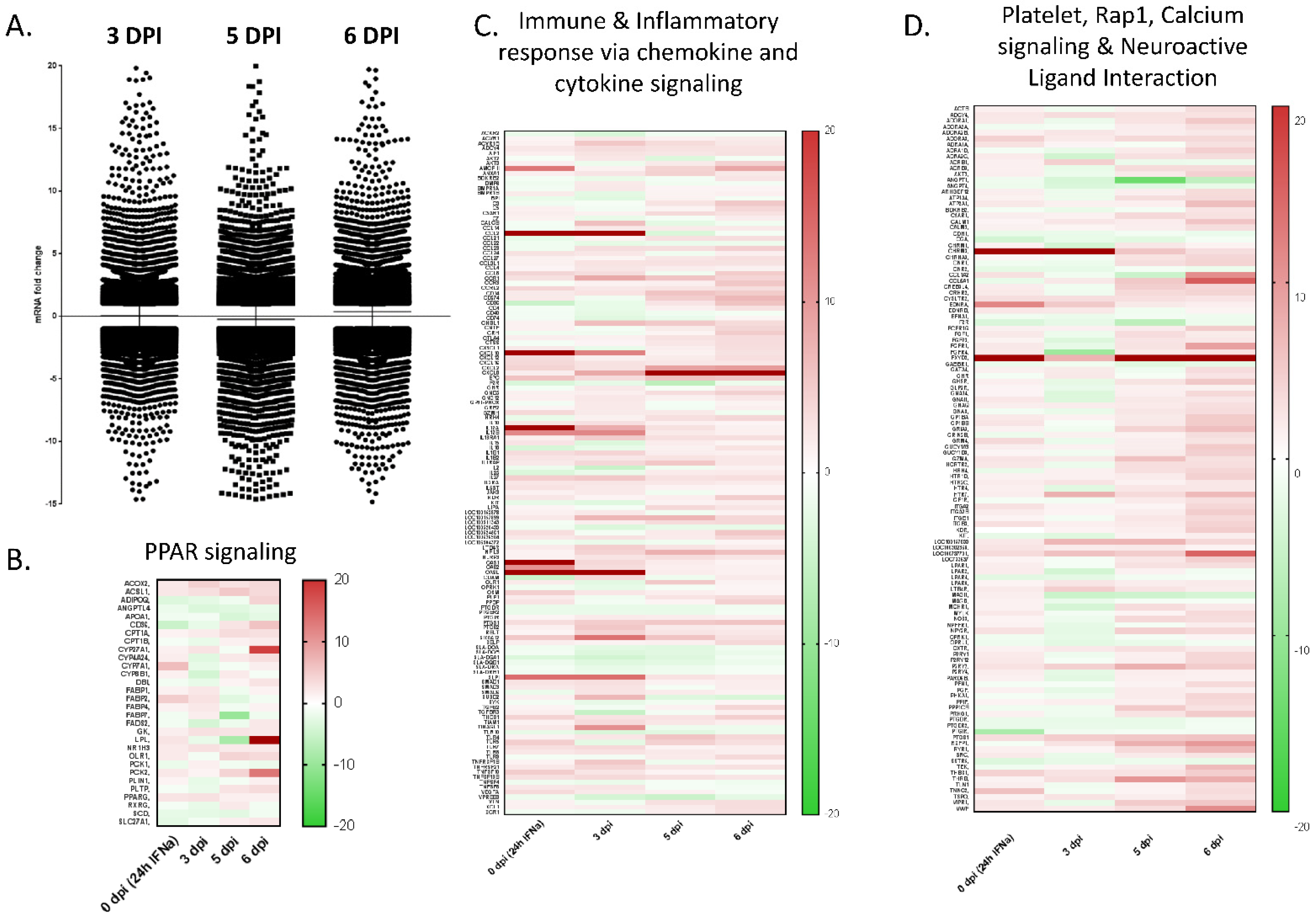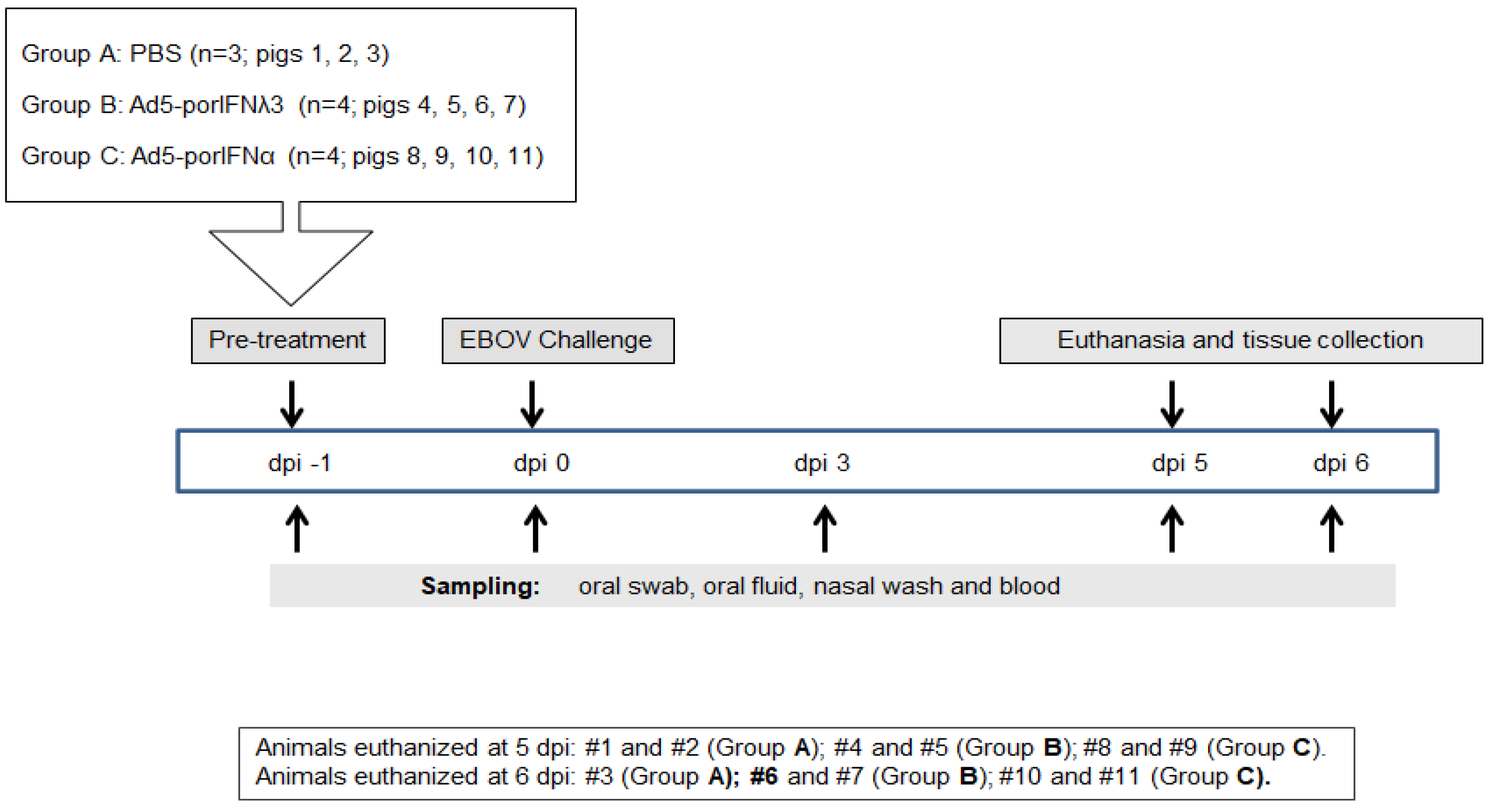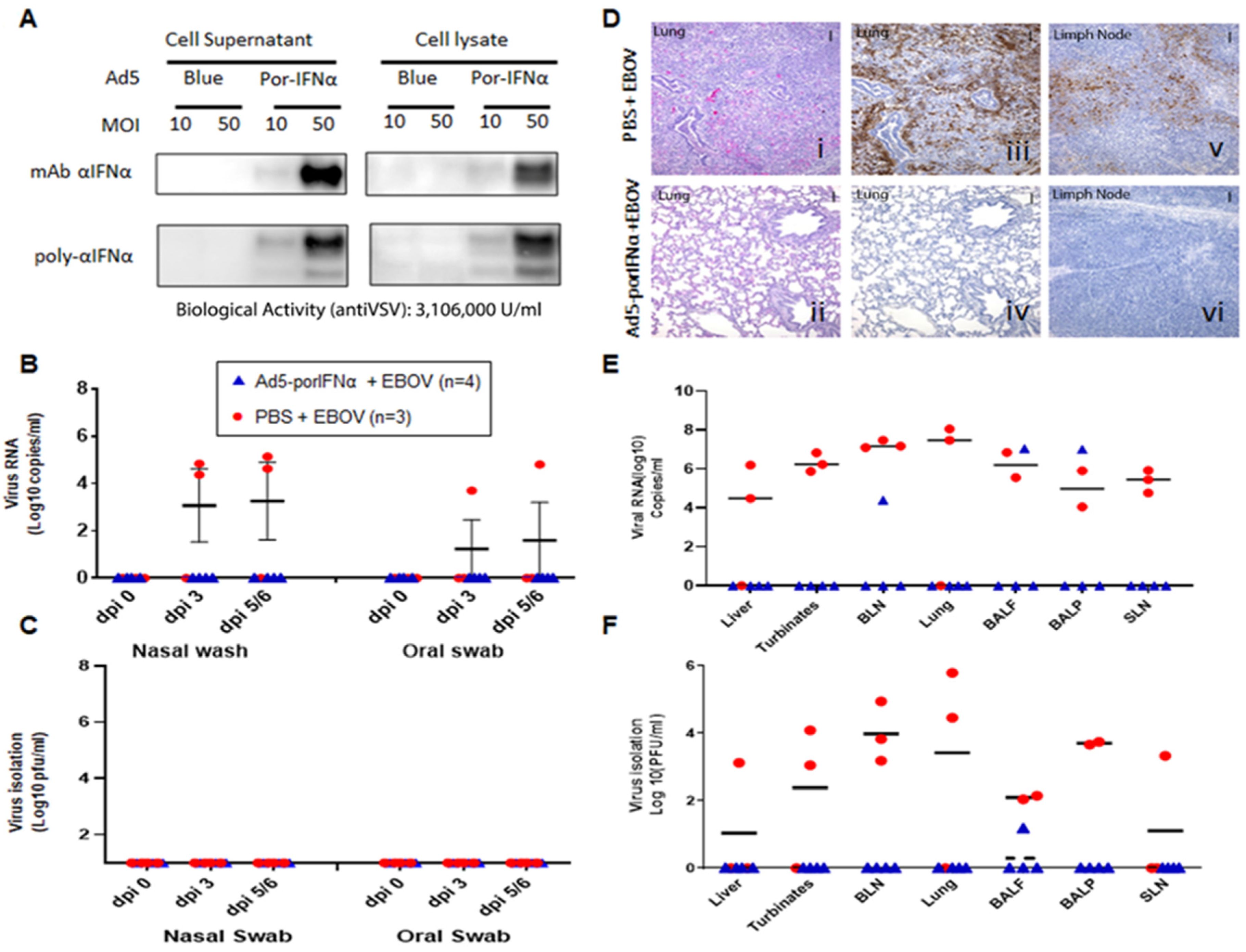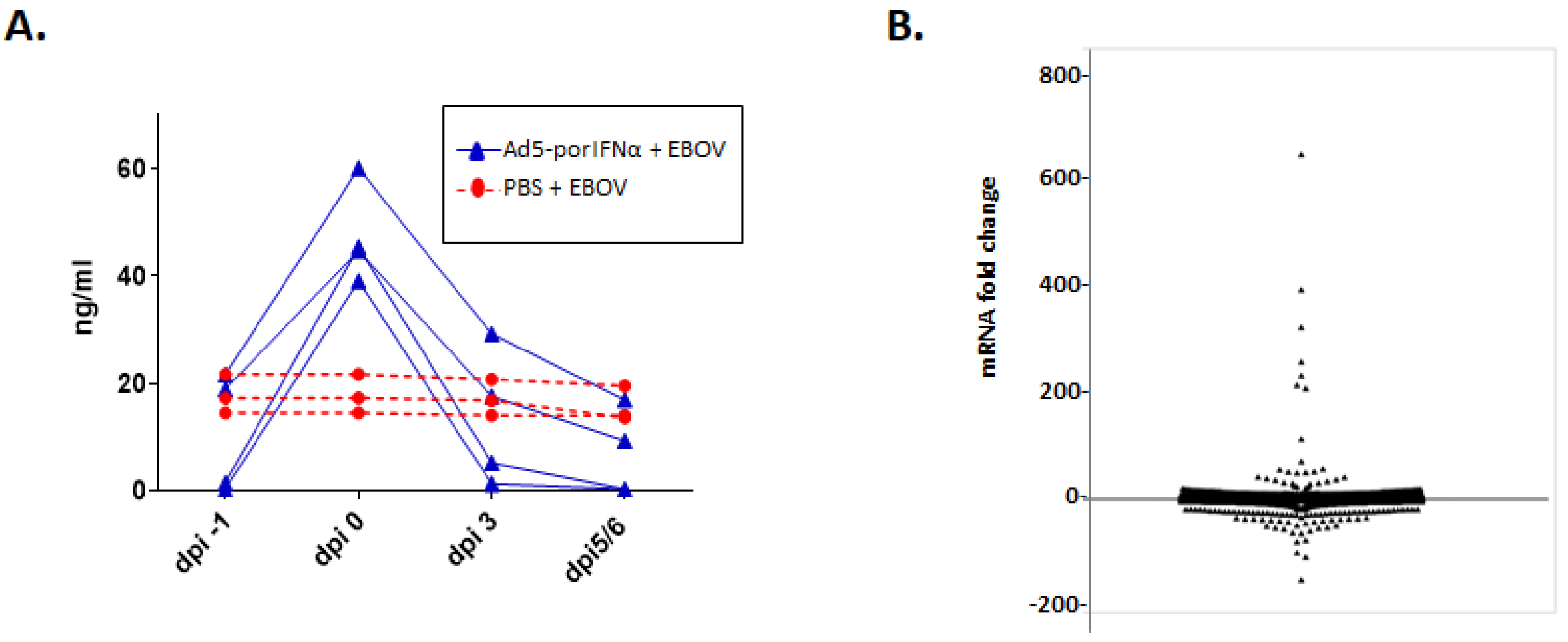Treatment with Ad5-Porcine Interferon-α Attenuates Ebolavirus Disease in Pigs
Abstract
1. Introduction
2. Results
2.1. Outcome of EBOV Inoculation of PBS-Treated Control Animals Was Consistent with Previous Laboratory Studies
2.2. Treatment with Ad5-porIFNλ3 Did Not Protect Pigs against EBOV
2.3. Administration of Ad5-porIFNα Attenuated EBOD and Prevented Virus RNA Shedding in Pigs
2.4. Analysis of the Response to Ad5-porIFNα Treatment
3. Discussion
4. Materials and Methods
4.1. Cell Lines and Viruses
4.2. Design and Construction of the Ad5-porIFN Vectors
4.3. Animal Study
4.4. EBOV Detection
4.5. Histopathology and Immunohistochemistry
4.6. Porcine IFNα Detection in Plasma by ELISA
4.7. Microarray & Bioinformatics
Author Contributions
Funding
Institutional Review Board Statement
Informed Consent Statement
Data Availability Statement
Acknowledgments
Conflicts of Interest
Appendix A

References
- Kuhn, J.H.; Adachi, T.; Adhikari, N.K.J.; Arribas, J.R.; Bah, I.E.; Bausch, D.G.; Bhadelia, N.; Borchert, M.; Brantsaeter, A.B.; Brett-Major, D.M.; et al. New filovirus disease classification and nomenclature. Nat. Rev. Microbiol. 2019, 17, 261–263. [Google Scholar] [CrossRef] [PubMed]
- Jahrling, P.B.; Geisbert, T.W.; Johnson, E.D.; Peters, C.J.; Dalgard, D.W.; Hall, W.C. Preliminary report: Isolation of Ebola virus from monkeys imported to USA. Lancet 1990, 335, 502–505. [Google Scholar] [CrossRef]
- WHO. Ebola Virus Disease. 2020. Available online: https://www.who.int/news-room/fact-sheets/detail/ebola-virus-disease (accessed on 4 April 2022).
- Leroy, E.M.; Epelboin, A.; Mondonge, V.; Pourrut, X.; Gonzalez, J.P.; Muyembe-Tamfum, J.J.; Formenty, P. Human Ebola outbreak resulting from direct exposure to fruit bats in Luebo, Democratic Republic of Congo, 2007. Vector Borne Zoonotic Dis. 2009, 9, 723–728. [Google Scholar] [CrossRef] [PubMed]
- Barrette, R.W.; Metwally, S.A.; Rowland, J.M.; Xu, L.; Zaki, S.R.; Nichol, S.T.; Rollin, P.E.; Towner, J.S.; Shieh, W.J.; Batten, B.; et al. Discovery of swine as a host for the Reston ebolavirus. Science 2009, 325, 204–206. [Google Scholar] [CrossRef]
- Marsh, G.A.; Haining, J.; Robinson, R.; Foord, A.; Yamada, M.; Barr, J.A.; Payne, J.; White, J.; Yu, M.; Bingham, J.; et al. Ebola Reston virus infection of pigs: Clinical significance and transmission potential. J. Infect. Dis. 2011, 204 (Suppl. S3), S804–S809. [Google Scholar] [CrossRef]
- WHO. Ebola Reston in Pigs and Humans, Philippines. WHO Weekly Epidemiological Record 7. 2009, pp. 47–50. Available online: https://apps.who.int/iris/handle/10665/241284 (accessed on 4 April 2022).
- Atherstone, C.; Diederich, S.; Pickering, B.; Smith, G.; Casey, G.; Fischer, K.; Ward, M.P.; Ndoboli, D.; Weingartl, H.; Alonso, S.; et al. Investigation of Ebolavirus exposure in pigs presented for slaughter in Uganda. Transbound. Emerg. Dis. 2021, 68, 1521–1530. [Google Scholar] [CrossRef]
- Fischer, W.A., 2nd; Vetter, P.; Bausch, D.G.; Burgess, T.; Davey, R.T.; Jr Fowler, R.; Hayden, F.G.; Jahrling, P.B.; Kalil, A.C.; Mayers, D.L.; et al. Ebola virus disease: An update on post-exposure prophylaxis. Lancet Infect. Dis. 2018, 18, e183–e192. [Google Scholar] [CrossRef]
- Kobinger, G.P.; Leung, A.; Neufeld, J.; Richardson, J.S.; Falzarano, D.; Smith, G.; Tierney, K.; Patel, A.; Weingartl, H.M. Replication, pathogenicity, shedding, and transmission of Zaire ebolavirus in pigs. J. Infect. Dis. 2011, 204, 200–208. [Google Scholar] [CrossRef]
- Weingartl, H.M.; Embury-Hyatt, C.; Nfon, C.; Leung, A.; Smith, G.; Kobinger, G. Transmission of Ebola virus from pigs to non-human primates. Sci. Rep. 2012, 2, 811. [Google Scholar] [CrossRef]
- Dhama, K.; Karthik, K.; Khandia, R.; Chakraborty, S.; Munjal, A.; Latheef, S.K.; Kumar, D.; Ramakrishnan, M.A.; Malik, Y.S.; Singh, R.; et al. Advances in Designing and Developing Vaccines, Drugs, and Therapies to Counter Ebola Virus. Front. Immunol. 2018, 9, 1803. [Google Scholar] [CrossRef]
- de Wit, E.; Marzi, A.; Bushmaker, T.; Brining, D.; Scott, D.; Richt, J.A.; Geisbert, T.W.; Feldmann, H. Safety of recombinant VSV-Ebola virus vaccine vector in pigs. Emerg. Infect. Dis. 2015, 21, 702–704. [Google Scholar] [CrossRef] [PubMed]
- Moraes, M.P.; Chinsangaram, J.; Brum, M.C.; Grubman, M.J. Immediate protection of swine from foot-and-mouth disease: A combination of adenoviruses expressing interferon alpha and a foot-and-mouth disease virus subunit vaccine. Vaccine 2003, 22, 268–279. [Google Scholar] [CrossRef]
- Fernandez-Sainz, I.; Ramanathan, P.; O’Donnell, V.; Diaz-San Segundo, F.; Velazquez-Salinas, L.; Sturza, D.F.; Zhu, J.; de los Santos, T.; Borca, M.V. Treatment with interferon-alpha delays disease in swine infected with a highly virulent CSFV strain. Virology 2015, 483, 284–290. [Google Scholar] [CrossRef][Green Version]
- Perez-Martin, E.; Diaz-San Segundo, F.; Weiss, M.; Sturza, D.F.; Dias, C.C.; Ramirez-Medina, E.; Grubman, M.J.; de los Santos, T. Type III interferon protects swine against foot-and-mouth disease. .J Interferon Cytokine Res. 2014, 34, 810–821. [Google Scholar] [CrossRef] [PubMed]
- Jahrling, P.B.; Geisbert, T.W.; Geisbert, J.B.; Swearengen, J.R.; Bray, M.; Jaax, N.K.; Huggins, J.W.; LeDuc, J.W.; Peters, C.J. Evaluation of immune globulin and recombinant interferon-alpha2b for treatment of experimental Ebola virus infections. J. Infect. Dis. 1999, 179 (Suppl. S1), S224–S234. [Google Scholar] [CrossRef] [PubMed]
- Konde, M.K.; Baker, D.P.; Traore, F.A.; Sow, M.S.; Camara, A.; Barry, A.A.; Mara, D.; Barry, A.; Cone, M.; Kaba, I.; et al. Interferon beta-1a for the treatment of Ebola virus disease: A historically controlled, single-arm proof-of-concept trial. PLoS ONE 2017, 12, e0169255. [Google Scholar] [CrossRef] [PubMed]
- Dias, C.C.; Moraes, M.P.; Weiss, M.; Diaz-San Segundo, F.; Perez-Martin, E.; Salazar, A.M.; de los Santos, T.; Grubman, M.J. Novel antiviral therapeutics to control foot-and-mouth disease. J. Interferon Cytokine Res. 2012, 32, 462–473. [Google Scholar] [CrossRef]
- Sommereyns, C.; Paul, S.; Staeheli, P.; Michiels, T. IFN-lambda (IFN-lambda) is expressed in a tissue-dependent fashion and primarily acts on epithelial cells in vivo. PLoS Pathog. 2008, 4, e1000017. [Google Scholar] [CrossRef]
- Chinsangaram, J.; Moraes, M.P.; Koster, M.; Grubman, M.J. Novel viral disease control strategy: Adenovirus expressing alpha interferon rapidly protects swine from foot-and-mouth disease. J. Virol. 2003, 77, 1621–1625. [Google Scholar] [CrossRef]
- Salata, C.; Calistri, A.; Alvisi, G.; Celestino, M.; Parolin, C.; Palu, G. Ebola Virus Entry: From Molecular Characterization to Drug Discovery. Viruses 2019, 11, 274. [Google Scholar] [CrossRef]
- Alexandersen, S.; Zhang, Z.; Donaldson, A.I.; Garland, A.J. The pathogenesis and diagnosis of foot-and-mouth disease. J. Comp. Pathol. 2003, 129, 1–36. [Google Scholar] [CrossRef]
- Diaz-San Segundo, F.; Moraes, M.P.; de Los Santos, T.; Dias, C.C.; Grubman, M.J. Interferon-induced protection against foot-and-mouth disease virus infection correlates with enhanced tissue-specific innate immune cell infiltration and interferon-stimulated gene expression. J. Virol. 2010, 84, 2063–2077. [Google Scholar] [CrossRef] [PubMed]
- Nfon, C.K.; Leung, A.; Smith, G.; Embury-Hyatt, C.; Kobinger, G.; Weingartl, H.M. Immunopathogenesis of severe acute respiratory disease in Zaire ebolavirus-infected pigs. PLoS ONE 2013, 8, e61904. [Google Scholar] [CrossRef] [PubMed]
- Williams, K.J.; Qiu, X.; Fernando, L.; Jones, S.M.; Alimonti, J.B. VSVDeltaG/EBOV GP-induced innate protection enhances natural killer cell activity to increase survival in a lethal mouse adapted Ebola virus infection. Viral Immunol. 2015, 28, 51–61. [Google Scholar] [CrossRef]
- Reed, D.S.; Hensley, L.E.; Geisbert, J.B.; Jahrling, P.B.; Geisbert, T.W. Depletion of peripheral blood T lymphocytes and NK cells during the course of ebola hemorrhagic Fever in cynomolgus macaques. Viral Immunol. 2004, 17, 390–400. [Google Scholar] [CrossRef] [PubMed]
- Caballero, I.S.; Honko, A.N.; Gire, S.K.; Winnicki, S.M.; Mele, M.; Gerhardinger, C.; Lin, A.E.; Rinn, J.L.; Sabeti, P.C.; Hensley, L.E.; et al. In vivo Ebola virus infection leads to a strong innate response in circulating immune cells. BMC Genom. 2016, 17, 707. [Google Scholar] [CrossRef]
- Kerber, R.; Krumkamp, R.; Korva, M.; Rieger, T.; Wurr, S.; Duraffour, S.; Oestereich, L.; Gabriel, M.; Sissoko, D.; Anglaret, X.; et al. Kinetics of Soluble Mediators of the Host Response in Ebola Virus Disease. J. Infect. Dis. 2018, 218, S496–S503. [Google Scholar] [CrossRef]
- DeWald, L.E.; Dyall, J.; Sword, J.M.; Torzewski, L.; Zhou, H.; Postnikova, E.; Kollins, E.; Alexander, I.; Gross, R.; Cong, Y.; et al. The Calcium Channel Blocker Bepridil Demonstrates Efficacy in the Murine Model of Marburg Virus Disease. J. Infect. Dis. 2018, 218, S588–S591. [Google Scholar] [CrossRef]
- Diaz-San Segundo, F.; Medina, G.N.; Azzinaro, P.; Gutkoska, J.; Mogulothu, A.; Attreed, S.E.; Lombardi, K.R.; Shields, J.; Hudock, T.A.; de Los Santos, T. Use of Protein Pegylation to Prolong the Antiviral Effect of IFN Against FMDV. Front. Microbiol. 2021, 12, 668890. [Google Scholar] [CrossRef]
- Pickering, B.S.; Collignon, B.; Smith, G.; Marszal, P.; Kobinger, G.; Weingartl, H.M. Detection of Zaire ebolavirus in swine: Assay development and optimization. Transbound. Emerg. Dis. 2018, 65, 77–84. [Google Scholar] [CrossRef]
- Kanehisa, M.; Goto, S. KEGG: Kyoto encyclopedia of genes and genomes. Nucleic Acids Res. 2000, 28, 27–30. [Google Scholar] [CrossRef] [PubMed]
- Ashburner, M.; Ball, C.A.; Blake, J.A.; Botstein, D.; Butler, H.; Cherry, J.M.; Davis, A.P.; Dolinski, K.; Dwight, S.S.; Eppig, J.T.; et al. Gene ontology: Tool for the unification of biology. Gene Ontol. Consort. Nat. Genet. 2000, 25, 25–29. [Google Scholar] [CrossRef] [PubMed]
- Benjamini, Y.; Hochberg, Y. On the Adaptive Control of the False Discovery Rate in Multiple Testing with Independent Statistics. J. Educ. Behav. Stat. 2000, 25, 60–83. [Google Scholar] [CrossRef]




| PM Testing (dpi) | Clinical Signs | Lung Pathology | Shedding (VI Nasal Wash) | Viral RNA (in Tissues) | Virus Isolation (in Tissues) | |
|---|---|---|---|---|---|---|
| Group A: PBS and EBOV | ||||||
| 1 | 5 | Depressed Increased RR | Pneumonia | + | + | + |
| 2 | 5 | Depressed | Pneumonia | + | + | + |
| 3 | 6 | Depressed | Pneumonia | + | + | + |
| Group B: Ad5-porIFNλ3 and EBOV | ||||||
| 4 | 5 | No | Pneumonia | + | + | + |
| 5 | 5 | No | Pneumonia | + | + | + |
| 6 | 6 | No | Pneumonia | + | + | + |
| 7 | 6 | No | Pneumonia | + | + | + |
| Group C: Ad5-porIFNα and EBOV | ||||||
| 8 | 5 | Mildly depressed | Normal | − | − | − |
| 9 | 5 | No | Normal | − | − | − |
| 10 | 6 | No | Normal | − | − | − |
| 11 | 6 | No | Normal | − | + | + |
| (BLN, BALF, BALP) | (BLN, BALF, BALP) | |||||
| KEGG Category | Genes | p-Value | FDR |
|---|---|---|---|
| Endocytosis | RAB4A, LOC100621443, SMAD2, HSP70, ARF5, KIT, CAPZB, FOLR1, ARPC2, CXCR4, RAB35, GRK5, VPS26A | 0.024 | 26.70 |
| Cytokine-cytokine receptor interaction | AMHR2, CCL2, IL6ST, CXCL9, IL15, KIT, CXCL11, CCL5, IL7R, IL10, TNFSF13B, CXCR4, LTA, IFNGR1 | 0.019 | 21.68 |
| Chemokine signaling pathway | CCL24, CCL2, CCL23, MAP2K1, CXCR4, PTK2B, CXCL9, GRK5, CXCL11, CCL5, XCL1, STAT3, CHUK | 0.007 | 8.74 |
| Herpes simplex infection | SRSF5, CCL2, TAF4B, HCFC2, ARNTL, OAS2, IL15, CCL5, PPP1CB, IFNGR1, CHUK, LTA | 0.025 | 27.74 |
| Biosynthesis of antibiotics | FNTB, PGP, ACADM, SQLE, OGDHL, BCKDHB, PLA2G7, PGAM2, PDHA1, CAT, OAT, HADHA | 0.034 | 35.86 |
| FoxO- signaling pathway | SGK1, MAP2K1, SMAD4/2, CAT, IL7R, INSR, ATM, CHUK, IL10, STAT3 | 0.008 | 9.67 |
| cGMP-PKG- signaling pathway | EDNRA, MEF2C, FXYD2, MEF2A, MAP2K1, PPP3CB, GUCY1A3, PDE3A, INSR, PPP1CB, MYLK | 0.034 | 35.52 |
| Osteoclast Differentiation | MAP2K1/K6, FCGR2B, PPP3CB, TREM2, IFNGR1, CHUK, SYK, BTK | 0.022 | 24.41 |
| NF-kappa B- signaling pathway | ICAM1, TNFSF13B, TNFAIP3, ATM, CHUK, LTA, SYK, BTK | 0.006 | 7.42 |
| Carbon metabolism | PGP, ACADM, MCEE, OGDHL, PGAM2, PDHA1, CAT, HADHA, PC | 0.014 | 16.55 |
| KEGG Category | Genes | p-Value | FDR |
|---|---|---|---|
| Inflammatory response | LIPA, CCL2, IL27, CXCL9, ACKR1, KIT, CXCL11, CCL5, IL10, CALCB, CCL23, LTB4R, XCL1, SYK | 0.003 | 5.40 |
| Transcription, DNA-templated | MEF2C, MEF2A, LIN52, KLF9, ESR1, SMAD2, ARNTL, GTF2H2, STAT3, NCOA1, NCOA3, ZSCAN21, BHLHE41, RSC1A1 | 0.083 | 76.41 |
| Immune response | CCL24, CCL23, TNFSF13B, CD274, CXCL9, OAS2, IL15, CXCL11, NFIL3, CCL5, TNFAIP3, XCL1, IL10 | 0.013 | 20.14 |
| Cell adhesion | ICAM1, CD9, SIGLEC1, APP, PTK2B, ATP4B, TNC, RHOB, FES, ENG, SPP1 | 0.004 | 6.14 |
| Chemokine-mediated signaling pathway | CCL2, CCL23, PTK2B, CXCR4, ACKR1, CXCL9, CCL5, CXCL11, XCL1 | 0.000 | 0.01 |
| Upregulation of ERK1 and ERK2 cascade | ICAM1, ALOX15, CCL2, CCL23, PTK2B, ANGPT1, CCL5, XCL1, GAS6 | 0.012 | 17.74 |
| Protein phosphorylation | APP, PHKB, PRKRA, PTPRA, PPP3CB, CDK4, MYLK, SYK | 0.008 | 12.74 |
| Positive regulation of gene expression | MEF2C, ACTA2, CD46, QKI, KIT, NFIL3, IL7R, GAS6 | 0.047 | 55.47 |
| Regulation of cell proliferation | SGK1, PTK2B, TNC, CXCL9, EGLN3, JAG1, CXCL11, FES | 0.060 | 64.01 |
| Cell chemotaxis | CCL24, CCL23, HBEGF, KIT, CCL5, CXCL11, XCL1 | 0.004 | 6.90 |
Publisher’s Note: MDPI stays neutral with regard to jurisdictional claims in published maps and institutional affiliations. |
© 2022 by the authors. Licensee MDPI, Basel, Switzerland. This article is an open access article distributed under the terms and conditions of the Creative Commons Attribution (CC BY) license (https://creativecommons.org/licenses/by/4.0/).
Share and Cite
Senthilkumaran, C.; Kroeker, A.L.; Smith, G.; Embury-Hyatt, C.; Collignon, B.; Ramirez-Medina, E.; Azzinaro, P.A.; Pickering, B.S.; Diaz-San Segundo, F.; Weingartl, H.M.; et al. Treatment with Ad5-Porcine Interferon-α Attenuates Ebolavirus Disease in Pigs. Pathogens 2022, 11, 449. https://doi.org/10.3390/pathogens11040449
Senthilkumaran C, Kroeker AL, Smith G, Embury-Hyatt C, Collignon B, Ramirez-Medina E, Azzinaro PA, Pickering BS, Diaz-San Segundo F, Weingartl HM, et al. Treatment with Ad5-Porcine Interferon-α Attenuates Ebolavirus Disease in Pigs. Pathogens. 2022; 11(4):449. https://doi.org/10.3390/pathogens11040449
Chicago/Turabian StyleSenthilkumaran, Chandrika, Andrea L. Kroeker, Gregory Smith, Carissa Embury-Hyatt, Brad Collignon, Elizabeth Ramirez-Medina, Paul A. Azzinaro, Bradley S. Pickering, Fayna Diaz-San Segundo, Hana M. Weingartl, and et al. 2022. "Treatment with Ad5-Porcine Interferon-α Attenuates Ebolavirus Disease in Pigs" Pathogens 11, no. 4: 449. https://doi.org/10.3390/pathogens11040449
APA StyleSenthilkumaran, C., Kroeker, A. L., Smith, G., Embury-Hyatt, C., Collignon, B., Ramirez-Medina, E., Azzinaro, P. A., Pickering, B. S., Diaz-San Segundo, F., Weingartl, H. M., & de los Santos, T. (2022). Treatment with Ad5-Porcine Interferon-α Attenuates Ebolavirus Disease in Pigs. Pathogens, 11(4), 449. https://doi.org/10.3390/pathogens11040449







